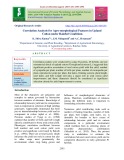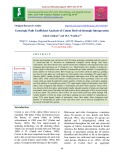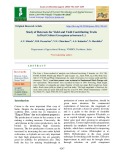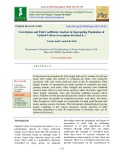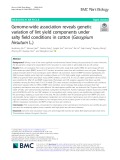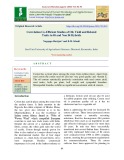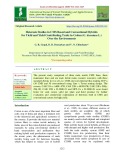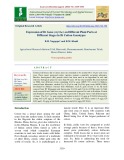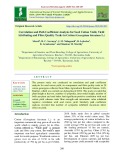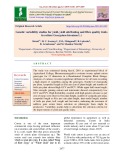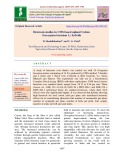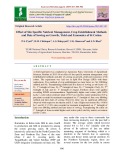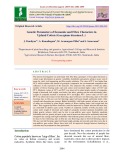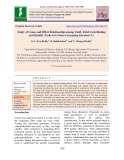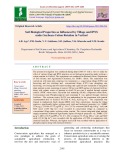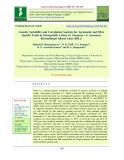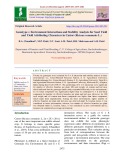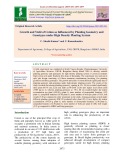
Cotton yield per plant
-
Correlation studies were conducted by using 10 parents, 45 hybrids and one commercial check of upland cotton (Gossypium hirsutum L.) suggested that significant positive association of seed cotton yield with lint yield, number of sympodia per plant, number of bolls per plant, number of monopodia per plant, reproductive point per plant, lint index, Ginning outturn, plant height, seed index and boll weight will play a major role in seed cotton yield improvement and these characters should be considered as significant selection criteria for yield improvement in cotton.
 4p
4p  cothumenhmong7
cothumenhmong7
 09-09-2020
09-09-2020
 17
17
 1
1
 Download
Download
-
Present investigation was carried out with 38 cotton genotypes including both the species G. arboreum and G. hirsutum in randomized complete block design with three replications. The observations were reported form three randomly selected plant from each treatment and replication on 17 characters viz., Plant height (cm), number of nodes per plant, length of internodes (cm), number of monopodia per plant, number of sympodia per plant, number of bolls per plant.
 7p
7p  nguaconbaynhay6
nguaconbaynhay6
 24-06-2020
24-06-2020
 11
11
 0
0
 Download
Download
-
The Line x Tester method of analysis was followed involving 5 females viz., PA 740, PA760, PA848, PA828 and PAIG 77 and 6 males viz., AKA 9703, JLA 505, RAC 024, AKA 7, PA 08 and Phule Dhanwantary for study of heterosis for various yield and fibre characters. The F1’s and their parents were evaluated in Randomized Block Design with two replications. Observations were recorded on Days to 50% flowering, Plant height (cm), Number of sympodia per plant, Number of bolls per plant, Boll weight (g), Seed index, Seed cotton yield per plant (g) and Lint index.
 9p
9p  trinhthamhodang1213
trinhthamhodang1213
 29-05-2020
29-05-2020
 12
12
 0
0
 Download
Download
-
Cotton is one of the most important fiber and cash crop of India and plays a dominant role in the industrial and agricultural economy of the country. Sixty crosses with thirteen parents and three checks viz., PKV-Hy-4, NHH-206 and NHH- 44 were grown in Randomized Block Design with two replications. The results showed that the tester AKH07R possessed the highest GCA effect for the seed cotton yield per hectare and also exhibited high GCA (in desirable direction) for the traits, number of sympodia, number of bolls per, harvest index and cotton seed yield per plant.
 10p
10p  trinhthamhodang1213
trinhthamhodang1213
 29-05-2020
29-05-2020
 6
6
 0
0
 Download
Download
-
In the present investigation the boll weight followed by number of bolls per plant, boll weight and number of sympodia per plant were positively associated with seed cotton yield per plant in the F2 populations.
 5p
5p  cothumenhmong5
cothumenhmong5
 17-05-2020
17-05-2020
 6
6
 1
1
 Download
Download
-
Salinity is one of the most significant environmental factors limiting the productivity of cotton. However, the key genetic components responsible for the reduction in cotton yield in saline-alkali soils are still unclear.
 13p
13p  viharuno2711
viharuno2711
 21-04-2020
21-04-2020
 11
11
 1
1
 Download
Download
-
Cotton has a proud place among the crops from earliest times. Apart from seed cotton the cotton seed oil also has very good quality and vitamin E. The oil content statistically positively correlation with seed cotton yield, seed index, bolls per plant, boll weight and sympodial branches. Monopodial branches exhibit no significant association with oil content.
 10p
10p  trinhthamhodang1212
trinhthamhodang1212
 06-04-2020
06-04-2020
 12
12
 2
2
 Download
Download
-
The present study comprised of three male sterile CMS lines, three maintainer lines and ten male fertile males (testers/ restorers) with three standard checks in two sets i.e. CMS and conventional thus making 60 F1s (30 CMS and 30 conventional) using Line x Tester mating design. The crosses, CAK 53A x AKH- 07R, CAK 23B x AKH-07R, CAK 23B x DHy286-1R, CAK 23B x R-2000-23 and SRT-1A x R-2000-26 were found better for seed cotton yield per plant and hold promise for further evaluation and commercial exploitation of heterosis both in CMS and conventional system for high yield.
 16p
16p  caygaocaolon4
caygaocaolon4
 04-04-2020
04-04-2020
 26
26
 2
2
 Download
Download
-
The 1329 F2, 174 B1 and 191 B2 plants were evaluated along with parents (Suvin and BCS 23-18-7) and its F1 for seed cotton yield and its component traits and fibre quality traits. Top 20 transgressive segregants were selected for seed cotton yield from all three segregation generations (F2, B1 and B2), recorded 104.02 to 169.46 per cent higher seed cotton yield than best parent BCS 23-18-7 (116.90 g/plant). Six transgressive segregants recorded 5 per cent early flowering (< 65 days) with a minimum of 50 per cent yield advantage (> 177 g) over BCS 23-18-7.
 12p
12p  trinhthamhodang4
trinhthamhodang4
 22-03-2020
22-03-2020
 9
9
 1
1
 Download
Download
-
Cotton yield losses due to insect pests are estimated to be around 10 to 14 per cent every year. These insect protected cotton varieties contain a naturally occurring substance, Bacillus thuringiensis (Bt) protein which has been used as an ingredient in safe and effective biological sprays for more than 50 years.
 15p
15p  cothumenhmong4
cothumenhmong4
 23-03-2020
23-03-2020
 11
11
 1
1
 Download
Download
-
The present study was conducted on correlation and path coefficient analysis for seed cotton yield, its components and fibre quality traits in 20 cotton genotypes collected from Main Agricultural Research Station, UAS, Raichur, which was carried out during kharif 2018. The study revealed that plant height at harvest, number of sympodia, inter nodal length, number of bolls per plant and seed index had significant positive correlation with seed cotton yield whereas traits fibre strength and micronaire value exhibited negative correlation with seed cotton yield.
 8p
8p  chauchaungayxua4
chauchaungayxua4
 18-03-2020
18-03-2020
 25
25
 1
1
 Download
Download
-
The study was conducted during kharif, 2018 at experimental block of Agricultural College, Bheemarayanagudi to evaluate twenty upland cotton genotypes for 15 characters in a Randomized Complete Block Design. Analysis of variance revealed significant differences for all traits revealing a high degree of variability among the genotypes. Number of monopodia per plant, sympodial length at fifty per cent of plant height and number of bolls per plant showed high GCV and PCV. While upper half mean length, fibre strength, ginning outturn and micronaire showed comparatively low GCV and PCV.
 11p
11p  caygaocaolon2
caygaocaolon2
 14-03-2020
14-03-2020
 15
15
 1
1
 Download
Download
-
A study of heterosis over checks was carried out with 24 Gosypium hirsutum entries comprising of 14 F1s produced by CMS method, 7 females and 2 males and 1 check were evaluated at three locations viz., Surat, Bharuch and Hansot. The experiment was laid out in a Randomized Complete Block design (RBD) with three replications. CMS based crosses heterosis over standard check ranged from -39.17 to 9.36 per cent. Three crosses viz., G(B) 20 x G.Cot.10, G(B) 20 x DHY-286-1 and LRK-516 x DHY-286-1 performed better for standard heterosis, where their SCA effects were also significantly higher.
 8p
8p  caygaocaolon3
caygaocaolon3
 09-03-2020
09-03-2020
 13
13
 0
0
 Download
Download
-
A field experiment was conducted at Agronomy Farm, University of Agricultural Sciences, Raichur in 2015-16 on effect of site specific nutrient management, crop establishment methods and date of sowing on growth, yield and economics of Bt cotton. The experiment was laid out in Split Plot Design (SPD) with three replications. Two methods of crop establishment as main factor viz. M1: Dibbling method and M2: Transplanting method and five dates of sowing as sub factor viz.
 7p
7p  trinhthamhodang3
trinhthamhodang3
 12-02-2020
12-02-2020
 16
16
 0
0
 Download
Download
-
The present investigation was performed with fifty-three genotypes of Gossypium hirsutum L. cotton to get information on genetic variability, heritability and genetic advance as per cent of mean for yield, yield supporting and fibre quality attributes. The value of PCV was higher than GCV which explains that instead of genotypic component, the environmental component also influences in the expression of the character. The characters like number of bolls per plant, number of flower bearing nodes and seed cotton yield recorded higher values of GCV and PCV.
 7p
7p  chauchaungayxua3
chauchaungayxua3
 07-02-2020
07-02-2020
 29
29
 0
0
 Download
Download
-
The present study was conducted during kharif-2014-15 with 37 genotypes to understand the association among the yield, yield attributing and quality traits in cotton. The experiment revealed that seed cotton yield had positive association with number of bolls per plant, boll weight and lint yield at both genotypic and phenotypic levels. Path analysis revealed that number of boll per plant and boll weight was showing negative direct effects at genotypic level and positive direct effects at phenotypic level. So that restriction selection is advisable for improving seed cotton yield.
 10p
10p  chauchaungayxua3
chauchaungayxua3
 07-02-2020
07-02-2020
 12
12
 0
0
 Download
Download
-
The present investigation was conducted during kharif 2016-17 with a view to study the effect of various tillage and IPNS practices on soil biological properties under soybean – cotton rotation in Vertisol. The experiment was conducted at Research Farm, Department of Soil Science and Agricultural Chemistry, Dr. PDKV, Akola. The experiment was carried out with main plot comprises two treatments i.e.
 10p
10p  chauchaungayxua3
chauchaungayxua3
 07-02-2020
07-02-2020
 17
17
 0
0
 Download
Download
-
Cotton, Recombinant inbred lines (RIL), phenotypic (PCV) and There is a limited genetic variability available in genetic resources of upland cotton (Gossypium hirsutum L.), which restricted the breeding activity. The objective of present study was evaluating the genetic variability in RIL population derived through intraspecific hybridization between RHAP 12 and RHAP 15 genotypes. The 222 RIL were evaluated during kharif 2018 at University of Agricultural Sciences Dharwad.
 11p
11p  nguaconbaynhay3
nguaconbaynhay3
 07-02-2020
07-02-2020
 20
20
 0
0
 Download
Download
-
Twenty six genotypes were evaluated for G × E interaction and stability analysis in three environments viz., Castor-Mustard Research Station, S. D. Agricultural University, Sardarkrushinagar (E1), Cotton Research Station, S. D. Agricultural University, Talod (E2) and Agricultural Research Station, S. D. Agricultural University, Kholwada (E3) (Gujarat, India) during kharif-rabi 2016-17.
 7p
7p  nguathienthan2
nguathienthan2
 26-12-2019
26-12-2019
 35
35
 0
0
 Download
Download
-
A field experiment was conducted at Krishi Vigyan Kendra, Chamarajanagar, University of Agriculture Sciences, GKVK, Bengaluru during Kharif 2016 to develop suitable planting geometry and genotypes for high density planting system of cotton in medium black cotton soil under Southern Dry Zone of Karnataka. The experiment was laid out in split plot design consisting of fifteen treatment combinations involving five planting geometry and three genotypes. The growth and yield of cotton differed significantly due to planting geometry and genotypes under high density planting system.
 5p
5p  nguathienthan2
nguathienthan2
 25-12-2019
25-12-2019
 18
18
 0
0
 Download
Download
CHỦ ĐỀ BẠN MUỐN TÌM








